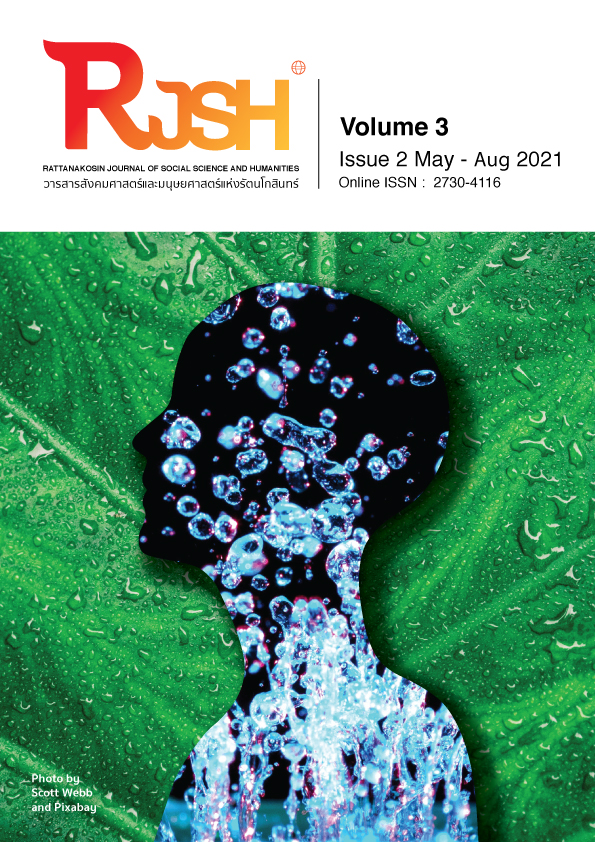The Suitable Health Fitness Center for The Urban Society
Main Article Content
Abstract
For demographic factors, it was found that most of the respondents are between 21-30 years of age, completed a bachelor’s degree, work for a private company, earns an average salary of 20,000-30,000 baht, attends fitness center 3-4 days per week, use the service from Monday to Friday, 1 -1.30 hours, and use the service from 4.00 - 6.00 PM. The qualified fitness center should possess modern equipment, safety in service, adequate fitness equipment, and service from the users' aspect. From the experts' aspect, the qualified fitness center should have sufficient equipment, declare usage descriptor label and benefit from using the equipment, be in convenient transportation, have enough parking lots, have staff to take care of, have a security system, clearly state the rules, etiquette, and regulations. Moreover, the experts recommend that government agencies regularly check the fitness center's performance, not get too many members, and charge at least 1,500 baht but not over 8,000 baht per month. The results of the willingness study show that the sample is highest willing to pay service fee of lower 1,000 baht per month (100%), 1,001-3,000 baht per month (80%), 3,001-6,000 baht (35%), 6,001- 10,000 baht (9.5%), 10,001-15,000 baht (1.5%), 15,001-21,000 baht (0.5%), and if the service fee is over 21,000 baht, there is no willingness to pay for the service.
Keywords: Health Fitness Center, Urban society, Suitable
Article Details
The content within the published articles, including images and tables, is copyrighted by Rajamangala University of Technology Rattanakosin. Any use of the article's content, text, ideas, images, or tables for commercial purposes in various formats requires permission from the journal's editorial board.
Rajamangala University of Technology Rattanakosin permits the use and dissemination of article files under the condition that proper attribution to the journal is provided and the content is not used for commercial purposes.
The opinions and views expressed in the articles are solely those of the respective authors and are not associated with Rajamangala University of Technology Rattanakosin or other faculty members in the university. The authors bear full responsibility for the content of their articles, including any errors, and are responsible for the content and editorial review. The editorial board is not responsible for the content or views expressed in the articles.
References
กระทรวงการพัฒนาสังคมและความมั่นคงของมนุษย์. (2554). คู่มือประชาชน กรุงเทพมหานคร.
กัลยา วานิชย์บัญชา. (2548). การใช้ SPSS for Windowsในการวิเคราะห์ข้อมูล, กรุงเทพฯ: ธรรมสาร.
นิภา เมธาวิชัย. (2543). วิทยาการวิจัย. กรุงเทพมหานคร : สถาบันราชภัฏธนบุรี.
พชร พันธวัชโกศล. (2558). การจัดพื้นที่ใช้ประโยชน์ภายในฟิตเนสเซ็นเตอร์: กรณีศึกษาฟิตเนสเฟิร์ส สาขาเดอะพรอมานาด กรุงเทพมหานคร. วิทยานิพนธ์สถาปัตยกรรมศาสตรมหาบัณฑิต, มหาวิทยาลัยกรุงเทพ.
มานพ เขตรุ่งเรื่อง. (2552). การวิเคราะห์พฤติกรรมและความพึงพอใจการเลือกใช้บริการสนามฟุตบอลหญ้าเทียมของผู้มาชิบริการในจังหวัดเชียงใหม่. การค้นคว้าอิสระเศรษฐศาสตร์บัณฑิต, มหาวิทยาลัยเชียงใหม่.
รัตนาวลี รักษาแสง. (2550). ปัจจัยที่มีผลต่อการใช้บริการศูนย์ฟิตเนส มหาวิทยาลัยเกษมบัณฑิต วิทยาเขตร่มเกล้า. การค้นคว้าอิสระ, มหาวิทยาลัยเกษมบัณฑิต.
วาสิกะสิน และคณะ. (2543). ความรู้ทั่วไปเกี่ยวกับสวัสดิการสังคมและสังคมสงเคราะห์. กรุงเทพมหานคร: มหาวิทยาลัยธรรมศาสตร์.
สมปอง จันทรี. (2544). ความพึงพอใจของผู้มาใช้บริการศูนย์กีฬา สนามกีฬาสมโภชเชียงใหม่ 700 ปี. การค้นคว้าอิสระเศรษฐศาสตรบัณฑิต, มหาวิทยาลัยเชียงใหม่.
สำนักงานกองทุนสนับสนุนการสร้างเสริมสุขภาพ. (2555). รายงานประจำปี 2555 สำนักงานกองทุนสนับสนุนการสร้างเสริมสุขภาพ (สสส.).
สำนักงานพัฒนาการกีฬาและนันทนาการ. (2551). รายงานประจำปี 2551 สพก. สำนักงานพัฒนาการกีฬาและนันทนาการ.
สำนักงานสถิติแห่งชาติ. (2558). สืบค้นเมื่อ 8 สิงหาคม 2562 จาก http://www.nso.go.th /sites/2014/DocLib13/ด้านสังคม/สาขาสวัสดิการสังคม/อนามัยและสวัสดิการ/สำรวจอนามัยและสวัสดิการ _2558/healthRep58.pdf
สุนันท์ ถูโคกหวาย. (2548). ปัญหาของผู้นำออกกำลังกายในศูนย์ออกกำลังกายเอกชน กรุงเทพฯ.
สุรีพร โรจนะศิริ. (2547). ความคิดเห็นของสมาชิกที่มีต่อการบริหารจัดการออกกำลังกายในศูนย์ฟิตเนสเฟิร์ส, ปริญญานิพนธ์การศึกษามหาบัณฑิตสาขาพลศึกษา, มหาวิทยาลัยศรีนครินทรวิโรฒ.
Economic Intelligence Center of Siam Commercial Bank. (2017). Fitness shapes up as new Asian growth industry. Retrieved 8 August 2019, from https://www.scbeic.com/th/detail/product/4071
Kemm, J. R. & Close, A. (1995). Health promotion: Theory and practice. Macmillan International Higher Education.
Lamp, D.R. (1984). Physiology of Exercise. New York: Macmillan Publishing.


